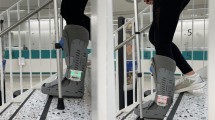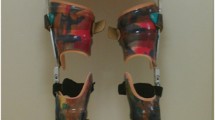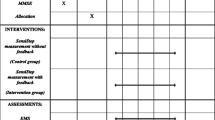Abstract
Introduction
Climbing up and down stairs with crutches is a particular challenge. The current study evaluates a commercially available insole orthosis device for weighing an affected limb and for biofeedback training of gait. This study was done on healthy, asymptomatic individuals before applying to the intended postoperative patient. The outcomes should demonstrate whether a continuous real-time biofeedback (BF) system is more effective on stairs than the current protocol involving a bathroom scale.
Materials and methods
59 healthy test subjects received both crutches and an orthosis and learned to apply a 3-point gait with a partial load of 20 kg using a bathroom scale. Thereafter, the participants were asked to complete an up-and-down course, first without (control group) and then with (test group) an audio-visual real-time biofeedback (BF). Compliance was evaluated using an insole pressure measurement system.
Results
Using the conventional therapy technique, 36.6% of the steps up and 39.1% of the steps down in the control group were loaded with < 20 kg. By activating continuous biofeedback, steps with < 20 kg could be increased significantly to 61.1% upstairs (p < 0.001) and 66.1% downstairs (p < 0.001). All subgroups profited from the BF system, independent of age, gender, side relieved, dominant or non-dominant side.
Conclusions
Traditional training without biofeedback led to poor performance for partial weight bearing on stairs, even among young and healthy individuals. However, continuous real-time biofeedback clearly improved compliance, indicating its potential to enhance training and support future research in patient populations.



Similar content being viewed by others
Data availability
This data is available for independent inspection or re-evaluation at any time, given explicit permission of the Head of the Department.
References
Fisher SV, Patterson RP (1981) Energy cost of ambulation with crutches. Arch Phys Med Rehabil 62(6):250–256
Nielsen DH, Harris JM, Minton YM, Motley NS, Rowley JL, Wadsworth CT (1990) Energy cost, exercise intensity, and gait efficiency of standard versus rocker-bottom axillary crutch walking. Phys Ther 70(8):487–493
Moran J, Murphy A, Murphy D, Austin A, Moran D, Cronin C et al (2015) The energy expenditure of non-weight bearing crutch walking on the level and ascending stairs. Gait Posture 42(1):23–26
Tveit M, Karrholm J (2001) Low effectiveness of prescribed partial weight bearing. Continuous recording of vertical loads using a new pressure-sensitive insole. J Rehabil Med 33(1):42–46
Hustedt JW, Blizzard DJ, Baumgaertner MR, Leslie MP, Grauer JN (2012) Is it possible to train patients to limit weight bearing on a lower extremity? Orthopedics 35(1):e31–e37
Vasarhelyi A, Baumert T, Fritsch C, Hopfenmuller W, Gradl G, Mittlmeier T (2006) Partial weight bearing after surgery for fractures of the lower extremity—is it achievable? Gait Posture 23(1):99–105
Fu MC, DeLuke L, Buerba RA, Fan RE, Zheng YJ, Leslie MP et al (2014) Haptic biofeedback for improving compliance with lower-extremity partial weight bearing. Orthopedics 37(11):e993–e998
Isakov E (2007) Gait rehabilitation: a new biofeedback device for monitoring and enhancing weight-bearing over the affected lower limb. Eura Medicophys 43(1):21–26
Bril AT, David V, Scherer M, Jagos H, Kafka P, Sabo A (2016) Development of a wearable live-feedback system to support partial weight-bearing while recovering from lower extremity injuries. Proced Eng 147:157–162
Raaben M, Holtslag HR, Augustine R, van Merkerk RO, Koopman BF, Blokhuis TJ (2017) Technical aspects and validation of a new biofeedback system for measuring lower limb loading in the dynamic situation. Sensors (Basel) 17:3
Braun BJ, Veith NT, Rollmann M, Orth M, Fritz T, Herath SC et al (2017) Weight-bearing recommendations after operative fracture treatment-fact or fiction? Gait results with and feasibility of a dynamic, continuous pedobarography insole. Int Orthop 41(8):1507–1512
Gray FB, Gray C, McClanahan JW (1998) Assessing the accuracy of partial weight-bearing instruction. Am J Orthop (Belle Mead NJ) 27(8):558–560
Youdas JW, Kotajarvi BJ, Padgett DJ, Kaufman KR (2005) Partial weight-bearing gait using conventional assistive devices. Arch Phys Med Rehabil 86(3):394–398
Funding
All authors certify that they have no affiliations with or involvement in any organization or entity with any financial interest or non-financial interest in the subject matter or materials discussed in this manuscript. The authors have no financial or proprietary interests in any material discussed in this article.
Author information
Authors and Affiliations
Contributions
TPM and TDS researched literature and conceived the study. CK was involved in protocol development and gaining ethical approval. NH and JS and TD were involved in patient recruitment and data analysis. TPM wrote the first draft of the manuscript. All authors reviewed and edited the manuscript and approved the final version of the manuscript.
Corresponding author
Ethics declarations
Conflict of interest
The authors have no competing interests to declare that are relevant to the content of this article.
Ethical approval
All procedures performed in studies involving human participants were in accordance with the ethical standards of the institutional and/or national research committee and with the 1964 Helsinki Declaration and its later amendments or comparable ethical standards. The study was approved by the local ethics committee of the University Tuebingen (protocol number 674/2021BO2).
Informed consent
Informed consent was obtained from all individual participants included in the study. Patients signed informed consent regarding publishing their data.
Additional information
Publisher's Note
Springer Nature remains neutral with regard to jurisdictional claims in published maps and institutional affiliations.
Rights and permissions
Springer Nature or its licensor (e.g. a society or other partner) holds exclusive rights to this article under a publishing agreement with the author(s) or other rightsholder(s); author self-archiving of the accepted manuscript version of this article is solely governed by the terms of such publishing agreement and applicable law.
About this article
Cite this article
Merkle, T.P., Hofmann, N., Schmidt, J. et al. Continuous real-time biofeedback in orthosis improves partial weight bearing on stairs. Arch Orthop Trauma Surg 143, 5701–5706 (2023). https://doi.org/10.1007/s00402-023-04878-y
Received:
Accepted:
Published:
Issue Date:
DOI: https://doi.org/10.1007/s00402-023-04878-y




